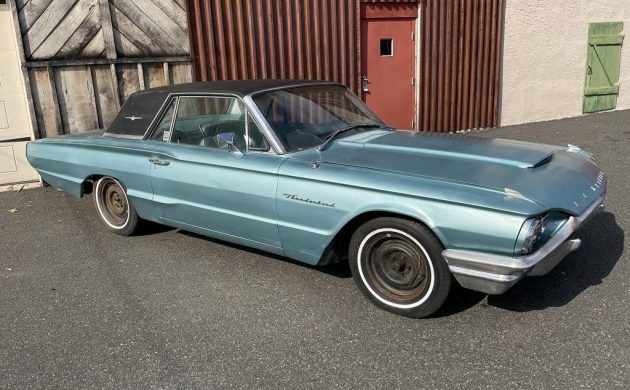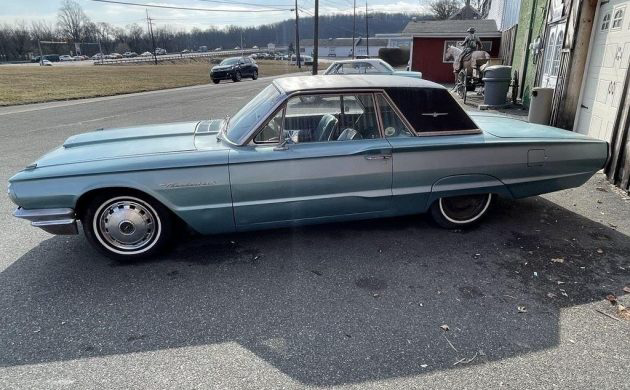When Ford released its Fourth Generation Thunderbird, its significant weight increase and softer suspension compared to its predecessors made it apparent that the company’s focus was more on luxury than outright performance. That didn’t make it a bad car because the V8 under the hood ensured it could continue to hold its own against the opposition. Our feature car is from that first year of production. While it will benefit from a new owner willing to lavish it with TLC, the seller has recently fitted many new parts that should allow it to be mechanically roadworthy. If you feel the overwhelming desire to tackle this restoration, you will find the T-Bird located in Boyertown, Pennsylvania, and listed for sale here on HiBid Auctions. Intense bidding has pushed the price to $3,500, although there’s plenty of time remaining if you wish to stake your claim on this classic. I have to say a big thank you to Barn Finder Andrew for spotting this iconic Ford for us.
The Thunderbird wears a combination of Patrician Green and Black, and there’s no denying it shows its age. The buyer will undoubtedly want to treat the car to a cosmetic refresh, although they might decide to embrace the “shabby chic” look by leaving it untouched. The exterior photos are inconclusive, but apart from some bumps and bruises, it appears that some of the lower extremities, like the quarter panels and front fenders, may have some developing rust. If so, it hasn’t deteriorated beyond the point of no return. The news is not as positive below deck, with this photo of the floor pan revealing what appears to be some penetrating rust. It is difficult to determine how far this has gone, so it isn’t possible to state whether patches or complete pans will be the best solution. The seller encourages in-person inspections, so climbing down on hands and knees should reveal the truth. Some trim pieces sit in the trunk, while those attached to the car look pretty good. There are no apparent issues with the glass, so this T-Bird could be a prime candidate for a DIY project.
Ford offered a single drivetrain configuration for the 1964 Thunderbird, so if you weren’t a fan of a 390ci V8, a three-speed automatic transmission, power steering, and power brakes, you needed to search elsewhere. Vehicle weight for 1964 rose substantially over the previous model year. Although both versions brought 300hp to the table, thanks to an additional 300lbs, the ¼ mile ET increased from 16.4 to 16.7 seconds. This left the T-Bird lagging behind natural competition like the Buick Riviera and Chrysler 300K, although it could hold its own against a similarly-equipped Pontiac Grand Prix. It seems that this Ford may be roadworthy because the owner has recently spent a few dollars on its mechanical components. He has installed a new fuel tank and sender unit and a shiny new Edelbrock carburetor. You can add new brake lines, hoses, wheel cylinders, plugs, and points to the list. He says that the car runs and drives, and if it isn’t roadworthy, it may not take a lot of time and effort to get it to that state.
Regardless of how much the next owner may save on labor costs with this restoration, the interior looks like it could consume some significant cash. It generally looks pretty worn, so seat upholstery, carpet, and a dash pad will need to go on the shopping list. This is where things become painful because seat upholstery can be hideously expensive. Leather will leave no change from $1,850 a set, while dash pads seem to be made from pure “unobtainium.” I admit that my internet search was relatively brief. If the buyer devotes more time to the process, it may produce better results. The wheel is cracked, and some of the plastic pieces are similar. However, before spending any money, it would be worth the time and effort to clean and assess everything first. Given the marginal financial nature of this project, it would be wise to replace only those parts that show significant deterioration.
There comes a time in many people’s lives when they must take stock of what they require in a classic car. While owning a hard-edged muscle or sports car can be attractive, sometimes a vehicle that offers a more comfortable and refined driving experience is a more appropriate choice. Finding a compromise can be challenging, but that might be where this 1964 Thunderbird fits into the picture. Its significant weight and soft suspension will blunt its outright performance, but flooring the “loud” pedal should unleash 300hp to provide respectable acceleration. The sticking point with this car could be its ultimate value once returned to its former glory. The harsh reality is that even if the buyer achieves perfection, this car will struggle to reach a value beyond $20,000. Depending on where the bidding closes, that may not leave a lot of room as a financially viable restoration. That means that the next owner will need to perform many of the tasks themselves to minimize labor costs. Do you feel up to that challenge?










I’m not a Ford fan or a Thunderbird fan, nor do I think this car is particularly good looking model, but I am always surprised that these sell for reasonable prices. It would make a great cruiser.
Sadly, no disc brakes or sequential turn signals (both new for 1965); the one wheel cover looks to be from a 1970-71 bird.
Everything about that interior screams “mid-century modern,” and I love it!
Get it for a good price, fix what needs to be fixed, and drive it.
There is a myriad of NICE models available, so why buy a can of worms?
I think every Tbird made from that era, is this blue color lol! I swear I rarely seen a different color offered back then.
I have always thought these were such beautiful cars inside and out. I agree with the “drive it as is” comment above. If you can’t deal with that – find a better one. Unfortunately 1964 is not the best year, as you could only get drum brakes that year, and you don’t get the sequential turn signals. Disks and the sequential turn signals became available in 1965. And in 1966 you could get a larger engine – so there’s that.